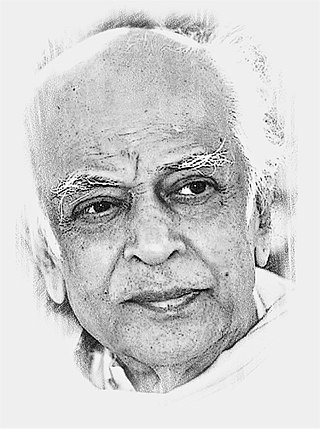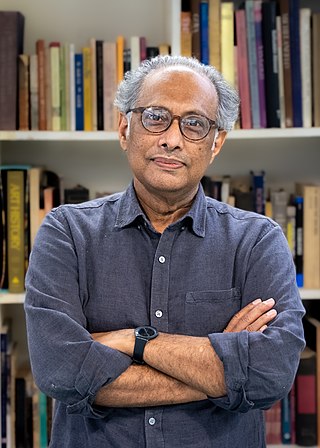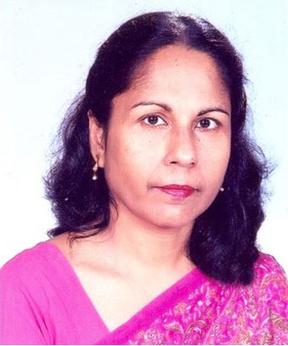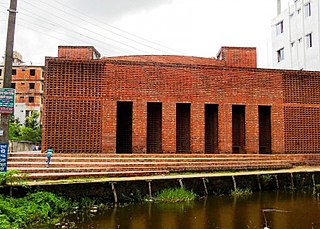
Dame Zaha Mohammad Hadid was an Iraqi-British architect, artist and designer, recognized as a major figure in architecture of the late-20th and early-21st centuries. Born in Baghdad, Iraq, Hadid studied mathematics as an undergraduate and then enrolled at the Architectural Association School of Architecture in 1972. In search of an alternative system to traditional architectural drawing, and influenced by Suprematism and the Russian avant-garde, Hadid adopted painting as a design tool and abstraction as an investigative principle to "reinvestigate the aborted and untested experiments of Modernism [...] to unveil new fields of building".

The Aga Khan Award for Architecture (AKAA) is an architectural prize established by Aga Khan IV in 1977. It aims to identify and reward architectural concepts that successfully address the needs and aspirations of Muslim societies in the fields of contemporary design, social housing, community development and improvement, restoration, reuse and area conservation, as well as landscape design and improvement of the environment.

Baitul Mukarram, also spelled as Baytul Mukarrom, is the National Mosque of Bangladesh. Located at the center of Dhaka, the national capital, the mosque was completed in 1968. It has a capacity of more than 42,000 worshippers.

The Architecture of Bengal, which comprises the modern country of Bangladesh and the Indian states of West Bengal, Tripura and Assam's Barak Valley, has a long and rich history, blending indigenous elements from the Indian subcontinent, with influences from different parts of the world. Bengali architecture includes ancient urban architecture, religious architecture, rural vernacular architecture, colonial townhouses and country houses and modern urban styles. The bungalow style is a notable architectural export of Bengal. The corner towers of Bengali religious buildings were replicated in medieval Southeast Asia. Bengali curved roofs, suitable for the very heavy rains, were adopted into a distinct local style of Indo-Islamic architecture, and used decoratively elsewhere in north India in Mughal architecture.

Muzharul Islam was a Bangladeshi architect, urban planner, educator and activist. He is considered as the Grand Master of regional modernism in South Asia. Islam is the pioneer of modern architecture in Bangladesh and the father of Bangali modernism. Islam's style and influence dominated the architectural scene in the country during the 1960s and 70s, along with major US architects he brought to work in Dhaka.

The Bengal Sultanate was a late medieval sultanate based in the Bengal region between the 14th and 16th century. It was the dominant power of the Ganges-Brahmaputra Delta, with a network of mint towns spread across the region. The Bengal Sultanate had a circle of vassal states in the Indian subcontinent, including parts of Odisha in the southwest, Arakan in the southeast, and Tripura in the east.

Architecture of Bangladesh is intertwined with the architecture of the Bengal region and the broader Indian subcontinent. The architecture of Bangladesh has a long history and is rooted in Bangladesh's culture, religion and history. It has evolved over centuries and assimilated influences from social, religious and exotic communities. The architecture of Bangladesh bears a remarkable impact on the lifestyle, tradition and cultural life of Bangladeshi people. Bangladesh has many architectural relics and monuments dating back thousands of years.

Rasem Jamal Badran is a Saudi Arabian/Jordanian architect of Palestinian descent whose works are based on a methodological approach in defining Architecture as a continuous dialogue between contemporary needs and historical inherited cultural values.

Muhammad Rafiq Azam is a Bangladeshi architect who is principal architect at Shatotto Architecture.

Shahbaz Khan Mosque is a historic mosque located in Dhaka, Bangladesh. Located near Mir Jumla’s Gate, this mosque serves as an example of late Mughal architecture in Bengal, known as the Shaista Khan architectural style.

Kazi Khaleed Ashraf is a Bangladeshi architect, urbanist and architectural historian. Writing from the intersection of architecture, landscape and the city, Ashraf has authored books and essays on architecture in India and Bangladesh, the work of Louis Kahn, and the city of Dhaka. His various writings on the architecture of Bangladesh have provided a theoretical ground for understanding both the historical and contemporary forms of architecture, while his written and design work on Dhaka advances that city as a "theorem" for understanding urbanism in a deltaic geography. Ashraf and contributing team received the Pierre Vago Journalism Award from the International Committee of Architectural Critics for the Architectural Design publication Made in India. He has also co-authored a number of publications with the architect Saif Ul Haque. Ashraf has recently established an international publication series called Locations: Anthology of Architecture and Urbanism that will present works and features from around the globe.
Kashef Mahboob Chowdhury is a Bangladeshi architect.

Saif Ul Haque is an architect and educator based in Dhaka. He received Aga Khan Award for Architecture in 2017-2019 cycle.
Ehsan Khan is a Bangladeshi architect and Urban Designer.

Khaleda Ekram was a Bangladeshi architect, professor, researcher, and academician. She served as the 12th vice-chancellor of Bangladesh University of Engineering and Technology (BUET). She was the former dean of the faculty of architecture and planning and head of the department of architecture at BUET. She was the first woman to be appointed as the vice-chancellor of BUET. She held the position from September 2014 until her death in May 2016.

Abu Sayeed Mostaque Ahmed is an architect and architectural conservation specialist from Bangladesh.

The Bait Ur Rouf Mosque is a distinctive urban mosque located in an economically-challenged area of Dhaka, Bangladesh. Designed by Bangladeshi architect Marina Tabassum and completed in 2012, it has been called a refuge of spirituality in urban Dhaka and received recognition for its beautiful use of natural light and for challenging the status quo of traditional mosque design. Instead of traditional symbolism such as domes and minarets, the mosque relies on open space and the rich interplay of light and shadow to create a prayer space that elevates the spirit.

Tamayouz Excellence Award is an international award for architecture established in 2012. It has eight prizes: six awards recognise individuals, student projects and institutions; two awards are thematic design competitions and a design challenge. Tamayouz Excellence Award runs an annual cycle of all awards. In addition to its prizes, Tamayouz organises public talks, conferences, design challenges and design workshops, and publishes an annual book that documents each cycle and the architectural ideas that are produced as a result.


















